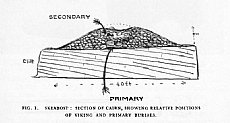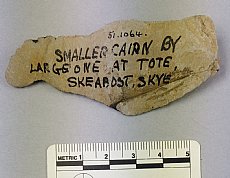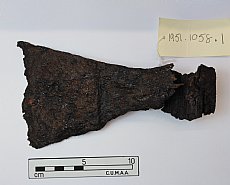Tote Cairn, Skye
03 February 2020
- News Type:
- Site of the Month

A large grass cairn situated on the shore towards the end of Loch Snizort Beag was excavated by T.C. Lethbridge before or in 1920. At the bottom was a rude cist formed of stones, suggesting a possible Bronze Age date. No bones were found, but a remarkably large number of flints as well as charcoal. Whether these were on the ground surface before the cairn burial was constructed is unclear, but the lithic material clearly has a wide date, with some said to be Mesolithic in date. The finds were later in the possession of Lethbridge, but two  cores and five flakes of chert are in Cambridge Museum of Archaeology and Anthropology; the whereabouts of the rest of the lithic material is unknown. The Cambridge objects are labelled ‘Smaller Cairn by large one at Tote, Skeabost, Skye’, suggesting that there may also have been two cairns at the site.
cores and five flakes of chert are in Cambridge Museum of Archaeology and Anthropology; the whereabouts of the rest of the lithic material is unknown. The Cambridge objects are labelled ‘Smaller Cairn by large one at Tote, Skeabost, Skye’, suggesting that there may also have been two cairns at the site.
 What makes this cairn unusual is that thousands of years later another grave was inserted at the top, this one for a Viking. The end of a femur and a few fragments of charred bone were all that remained of the body. Gravegoods consisted of an iron battle axe (still preserving wood in the haft); a sandstone hone, hammerstone or possibly even a Neolithic axehead (see below); a bead of ivory or bone (probably lost); a copper-alloy ringed pin; iron fragments, probably part of a casket; and rivets. It is one of the few Viking cremation burials in Scotland, and a rare survival of evidence of a box. The axe when compared to other Viking examples suggests a date of around the 10th century (pers. comm. Caroline Paterson).
What makes this cairn unusual is that thousands of years later another grave was inserted at the top, this one for a Viking. The end of a femur and a few fragments of charred bone were all that remained of the body. Gravegoods consisted of an iron battle axe (still preserving wood in the haft); a sandstone hone, hammerstone or possibly even a Neolithic axehead (see below); a bead of ivory or bone (probably lost); a copper-alloy ringed pin; iron fragments, probably part of a casket; and rivets. It is one of the few Viking cremation burials in Scotland, and a rare survival of evidence of a box. The axe when compared to other Viking examples suggests a date of around the 10th century (pers. comm. Caroline Paterson).
There is some confusion about the site, as Lethbridge published it in 1920, but states that the cairn was excavated in 1922, a mistake which is picked up by some later commenters. Some of the labelling on finds suggested there may have been a second cairn (see above), or perhaps this too is in error. Lethbridge’s published account mentions a stone hone, but the Cambridge Museum catalogue has listed it as a stone axehead. This object was not available for examination in 2020, but should be checked again. If it is a stone axe, it is unusual to find a Neolithic axehead in a Viking burial.
The cairn is important for showing multi-period use, and important evidence of the Viking presence on Skye. The preservation of wood allows the possibility of carbon-14 dating in the future, and if some of the charcoal from the original burial can be traced, the possibility of dating this earlier phase.
Note:
Thanks to Caroline Paterson for discussing the Viking burial finds, in advance of publication in the Viking Graves corpus, and her re-identification of some of the Viking Age material. The chert lithics and iron axehead were examined in January 2020, but other finds in the Cambridge Museum of Archaeology and Anthropology collection were not available to view. The finds are catalogued as 1951.1058, 1951.1064 and Z 20850.
Further information
Highland HER MHG5134
Canmore 11283
Lethbridge, T.C. 1920. ‘A burial of the ‘Viking Age’ in Skye,; Archaeological Journal v. 77, 135-6. Available online from ADS
Contributed by Susan Kruse
Site of the Month Archive
- 10/04/2021 Easter Raitts township
- 02/03/2021 Lower Slackbuie, Inverness (ASDA) Neolithic site
- 01/02/2021 Balnuaran of Clava cairns
- 04/01/2021 Wilkhouse Inn
- 02/12/2020 Spinningdale Cotton Mill
- 02/11/2020 Skibo A Canadian Forestry Camp
- 01/10/2020 WWI Detonator Store, Dalmore near Invergordon
- 03/09/2020 Mesolithic Shell Midden at Sand, Wester Ross
- 08/08/2020 Kinbeachie Neolithic settlement
- 01/07/2020 Armadale Cist Burial and Stone & Timber Complex
